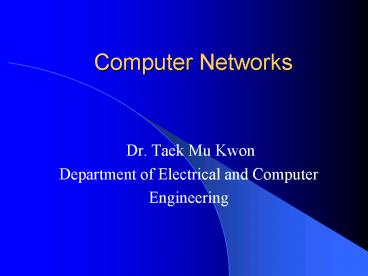Computer Networks - PowerPoint PPT Presentation
1 / 23
Title:
Computer Networks
Description:
Course Objective: On completion of this course students are expected to learn ... by Dow Corning Scientists: Dr. Donald Keck, Dr. Bob Maurer and Dr. Peter Schultz ... – PowerPoint PPT presentation
Number of Views:29
Avg rating:3.0/5.0
Title: Computer Networks
1
Computer Networks
- Dr. Taek Mu Kwon
- Department of Electrical and Computer
- Engineering
2
Outline
- ECE 4321
- Network architecture
- Optical fiber
- DSL
3
ECE 4321 Computer Networks
- ECE Technical Elective Course
- 3 Credits
- Network Lab (MWAH 60)
- Network Programming Project (3 4)
- Written Exams
- Course Objective On completion of this course
students are expected to learn and understand
characteristics of network transmission media,
OSI model, TCP/IP, data link protocols, routing
algorithms, various LAN technologies, WAN
technologies, and network programming.
4
Integrated Service Revolution (1990 - )
- The fundamental difference between data
processing (computer) and data communication
(transmission and switching equipment) have
blurred. Ex) Half of OS is concerned with
computer networks. - The fundamental difference among data, voice, and
video communication have blurred. - The line between single-processor computer,
multi-processor computer, local network,
metropolitan network, and long-haul network have
blurred. - WWW became an integration point of all types of
communications data, voice, video.
5
OSI Model
6
Electromagnetic Spectrum
7
Transmission Characteristics of Guided Media
8
Attenuation of Typical Guided Media
9
Optical Fiber
- Invented in Aug. 1970 by Dow Corning Scientists
Dr. Donald Keck, Dr. Bob Maurer and Dr. Peter
Schultz - Invention was motivated by space limitation of
telephone wires - First large commercial use nationwide
long-distance telephone network by MCI using
single-mode optical fiber, 1983
10
What is Optical Fiber?
- A thin flexible medium capable of conducting an
optical ray. The basic material consists of
silicon dioxide, silica, and plastic.
11
Internal Structure of Optical Fiber
12
Snells Law
qt
Cladding Refractive index n2
qi
Fused Silica Refractive index n1
13
Optical Fiber Types
- Multimode (Orange Color)
- Stepped index
- Grade index
- Singlemode (Yellow Color)
- The fiber diameter is one wavelength of light
(1um)
14
(No Transcript)
15
Wavelengths Used in Optical Fiber(Infrared
region)
- 850 nm --- used in most LAN, travel shorter
distance, generated by LEDs - 1300 nm --- higher data rates, longer distances,
LED or Laser - 1550 nm --- highest data rates, longest distance,
Laser
16
Wavelength Division Multiplexing (WDM)
- Multiple beams of different wavelengths are
transmitted over the same fiber - Transmission of one Tbps was achieved by 100
beams each operating at 10 Gbps (1997 Bell Lab)
17
Characteristics of Optical Fiber
- Greater bandwidth
- Smaller size and light weight
- Lower attenuation
- EM isolation
- Greater repeater spacing
- Greater security
18
DSL, ADSL (Asymetric Digital Subscriber Line)
- Connecting new wires for high-speed transmission
to subscribers new home is expensive - Voice graded telephone lines are band limited to
4KHz by Local Branch Office, but capable of
transmitting 1MHz or more. - ADSL provides high-speed transmission over
ordinary telephone line (typ. 2Mbps, but up to
9Mbps)
19
ADSL Design
- Uses FDM in a novel way
- Allocates the lowest 25KHz for voice
- Smaller upstream and larger downstream band
- A single bit stream is split into multiple
parallel bit streams, where each portion is
carried in a separate frequency
20
(No Transcript)
21
Discrete Multi-tone (DMT)
- The available transmission band is divided into
4KHz subchannels (0 to 60Kbps). - DMT modem tests each channels signal to noise
(S/N) ratio. - More bits are assigned to high S/N ratio
channels - Present ADSL/DMT employs 256 downstream
subchannels. - Theoretical Limit 25660K15.36 Mbps
- (In practice 1.5 to 9Mbps)
22
Discrete Multi-tone (DMT)
23
xDSL Comparison































